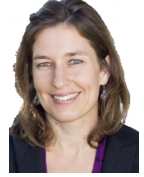WHAT WE CAN LEARN FROM THE ENVIRONMENTAL CHARTERS-About ten years ago, a community activist, Alison Suffet-Diaz, looked around and saw many circumstances about which she was very concerned. Two, in particular, stood out --education and the environment. She thought it is easy for people to complain about them and then do nothing, so she decided literally to put her money where her mouth was. Until then she was a practicing attorney. After that--a teacher and finally Executive Director of her own charter school (in partnership with the Lawndale Elementary School District). The two issues compose the major part of the curriculum of the institute she founded, the Environmental Charter Schools--the initial high school (which I visited) and two subsequent middle schools.
After receiving an invitation, I attended a special culminating event for ninth through twelfth graders for the Intercession month-long program (between the fall and spring semesters).
The campus is amazing, filled with eager students (who provide their own transportation) from all over the South Bay area. The classrooms have a ratio of about 25-30 students for every teacher.
The Intercession projects are inter-disciplinary. Every team of 6-7 young people rotate through a cycle of history, English, math, science, and foreign language classes with the addition of one elective such as art or horticulture.
They grow their own fruit and vegetables and even raise chickens (I saw several poking around) and fish. Everything is recycled--from paper to plastic to cans and electrical paraphernalia.
The program promotes alternative forms of transportation for the community at large. To encourage this philosophy, there is a bicycle shop on campus. Walking is encouraged as well as carpooling when there is no other option.
I was struck by the many rain barrels, all of which were full because of the recent rains. The catch water is utilized for irrigation for their on-campus plants.
The school has corporate partners (such as AAA Flag & Banner) which help defray costs. Using some of this money, the students and teachers have built a greenhouse that is designed with solar power.
The landscaping is awesome with a man-made river running through the campus. The school has built an outdoor amphitheater where students gather for assemblies or interactive discussion groups.
The teachers are inspirational--so caring and devoted, so knowledgeable and creative, and so very approachable! Often students are taken on walking trips to meet their school’s neighbors and discuss their concerns. On-campus horticulturalists share their expertise on the types of plants that are drought-resistant and/or native to the environment--obviously preferable for our landscaping strategies in this time of drought (remember, Governor Brown is asking for us to reduce our water usage voluntarily by 20% before it becomes an enforceable mandate).
The students also become knowledgeable about permeable pavements and sidewalks which greatly reduce the amount of wasted run-off from irrigation systems and natural downpours. They are taught about proper placement of shops and other buildings so that potable water is not polluted by exposure to contaminants from gas stations and other problematical sites.
At other times, there are field trips that take the students to see how parks are designed and how rooftop solar can offset customer costs. (Did you know, incidentally, that Mitch Englander, a staunch environmental advocate, is the only Los Angeles City Councilmember whose home is completely equipped with solar, having had start-up costs reduced substantially through rebates and whose electric bills are structured for net-zero metering?)
Assemblymember Steven Bradford, who represents the region, was at the event and spoke with many students, teachers, and other guests, giving his strong support for these kinds of programs. He believes it is a wonderful concept and indicated that the State is working on legislation to provide this opportunity for 3- and 4-year olds, regardless of income. A mandate for universal pre-school would make such a difference for all our children in the short run and, in the long run, for our entire society.
The pupils here at each grade level are required to provide 20 hours a year of service to the community--something which can be accomplished in any number of ways. Despite what one might expect from this requirement, these young people are eager to participate, particularly after their Intercession experiences.
 The principal, Ms. Jenni Taylor, shared with me the vision of these sessions. Intercession is an “innovative, interdisciplinary, month-long learning experience that aligns California Newly Adopted Common Core Standards and next-generation science standards.” Emphasis is on analytical, project-based, hands-on learning. Thus, little of the more typical lecture method is employed. Some forums by the students and teachers are presented during the day but others are given during the evening in order to accommodate the working schedules of many parents and guardians.
The principal, Ms. Jenni Taylor, shared with me the vision of these sessions. Intercession is an “innovative, interdisciplinary, month-long learning experience that aligns California Newly Adopted Common Core Standards and next-generation science standards.” Emphasis is on analytical, project-based, hands-on learning. Thus, little of the more typical lecture method is employed. Some forums by the students and teachers are presented during the day but others are given during the evening in order to accommodate the working schedules of many parents and guardians.
Each grade level is assigned a discrete project. Ninth grade: “What is the quality of life?” It concentrates on the architectural designs that can produce both comfort and energy/water efficiencies as well as open space for family recreation. This group created models of communities, built at scale, to demonstrate how efficient neighborhoods can be conducive to a quality life style and better standard of living for all.
Tenth graders are assigned “How and why does change happen?” The emphasis is on how art and history have influenced each other throughout the ages. College preparation and career counseling are a significant part of this. In fact, students must be accepted to a college before they can be graduated from the high school.
“What is truth and from where does it come?” is the eleventh grade project. The students work on issues like environmental justice, financial literacy (which they also impart to their own parents or guardians).
Finally, the twelfth grade senior project encompasses the theme, “Why does my community need me?” Each student must write a paper based upon his or her thoroughly researched topic and must also devote 20 hours of service related directly to the selected theme.
I was especially impressed by their presentations. One student in particular, Kate Spence, blew me away. She became so engaged by her project that she has become a passionate advocate for rescuing the Arctic interconnected community of plants, animals, humans, all of which require potable water to sustain life. Her topic: Mercury contamination in the Arctic and its effect on the indigenous people there (taking into consideration the food, culture, clothing, and so forth of the various genera).
She became so dedicated to getting first-hand facts that she and her mother (with the assistance of Jet Blue Airlines) flew to Juneau, the capital of Alaska, to meet with Professor Sonia Nargoski whom she “shadowed” through the professor’s research and teaching days. Kate’s experience has had such an impact on her life that she plans to return soon to the University of Alaska Southeast through an internship.
It is clear to me that this school with its innovative and inter-active learning methods has forever changed her life in a way that may otherwise not have happened. Similar responses are experienced every day by the entire student-body--a remarkable result emerging from the early vision of Ms. Suffet-Diaz and her partners.
Other students on Kate’s team had projects of their own about which they were equally passionate: NAFTA and its impact on the affected international economies and on the lives of all immigrants to our country. Another was concerned with elder abuse and spoke so lovingly of the “fragile, sweet” older people, that her presentation was truly touching.
Yet another was concerned with genetically modified organisms (the much referenced GMOs) that make their way into the food cycle in a way that hurts the entire flora and fauna spectrum.
One diminutive young lady burst with enthusiasm over her support of healthy, fresh, affordable foods that can be obtained through farmers’ markets and urban gardens for the low-income community of color.
In fact, most of these “professional,” prepared, and well-dressed students represent a variety of minorities, most coming from disadvantaged neighborhoods. It was inspiring to listen to these future leaders who just might be able to reverse the calamitous errors that earlier generations have so selfishly produced--actions which undoubtedly have caused so many of the problems we currently face in the first place!
● For more information, please view the website at echslawndale.org or contact the principal, Ms. Jennie Taylor, at 310-214-3400.
(Rosemary Jenkins is a Democratic activist and chair of the Northeast Valley Green Coalition. Jenkins has written Leticia in Her Wedding Dress and Other Poems, A Quick-and-Easy Reference to Correct Grammar and Composition and Vignettes for Understanding Literary and Related Concepts. She also writes for CityWatch.)
-cw
CityWatch
Vol 12 Issue 12
Pub: Feb 11, 2014




